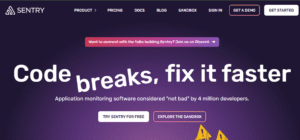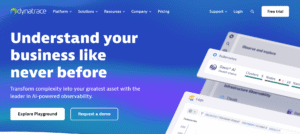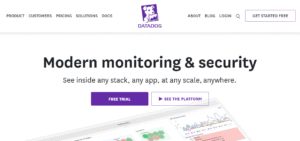Table of Contents
ToggleGrafana, popular for its open-source dashboards and seamless integration with Prometheus, Loki, and Tempo, has been the go-to observability stack for engineering and DevOps teams. It powers over 25 million global users and is widely adopted for custom time-series dashboards, cloud-native monitoring, and open-source flexibility (Grafana Labs, 2025).
However, as cloud-native environments become more complex, many teams are beginning to seek alternatives that go beyond Grafana’s visualization capabilities. DevOps teams and software engineers are considering tools that provide comprehensive and straightforward MELT(Metrics, Events, Logs, Traces) coverage, AI-driven insights, and compliance-ready deployment options. The shift from DIY observability to fully integrated APM platforms is driving a new wave of interest in tools that combine ease of use with deep backend intelligence.
CubeAPM stands out as a strong competitor to Grafana, offering out-of-the-box end-to-end observability with native OpenTelemetry support, real-time alerting, and cost-efficient smart sampling. It eliminates the burden of manually configuring separate components for metrics (Prometheus), logs (Loki), and traces (Tempo), as is required with Grafana. CubeAPM gives teams full control over data flow, pricing, and performance, making it a highly scalable Grafana alternative for modern engineering teams.
This article shares valuable insights on the Top 7 Grafana alternatives, comparing the tools based on features, real-time performance monitoring, pricing, and customer reviews.
Top 7 Grafana Alternatives
- CubeAPM
- DataDog
- DynaTrace
- Splunk AppDynamics
- New Relic
- CoraLogix
- Sentry
Why Look for Grafana Alternatives?
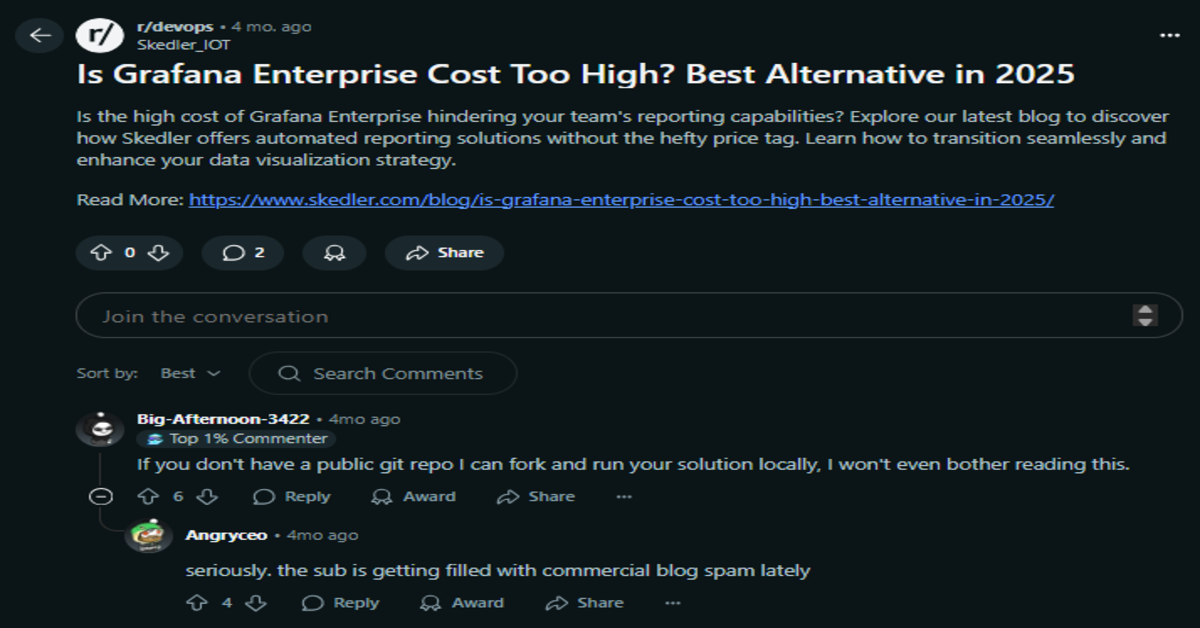
Grafana is a powerful tool, but it was never built to be a full observability platform. Most of its capabilities rely on connecting third-party backends—Prometheus for metrics, Loki for logs, Tempo for traces, and Alertmanager for alerts. As teams mature their DevOps and SRE practices, Grafana’s limitations become more evident:
1. Fragmented Stack
Grafana has multiple backends to manage, increasing complexity, especially during setup and configuration. For full-stack observability, Grafana’s LGTM stack(Loki, Grafana, Tempo, Mimir) requires a manual configuration of separate components: Prometheus(metrics), Loki(Logs), Tempo(Traces). This fragmented stack adds a layer of complexity that adds operational overhead.
2. Lack of Native MELT Coverage
Unlike APM tools like New Relic, Dynatrace, or CubeAPM, Grafana doesn’t natively handle all telemetry types (metrics, logs, traces, events). This fragmented data model delays insights and complicates correlation during incidents.
3. Sampling requires custom OTEL processor configuration
Grafana’s backend tools like Tempo and Loki support OpenTelemetry ingestion, but they do not offer built-in smart sampling. To implement trace sampling effectively, teams must manually configure custom OpenTelemetry Collector processors, which adds operational complexity. This lack of native, intelligent sampling makes it harder to reduce noise and control data volumes—especially at scale—prompting teams to look for alternatives with built-in, context-aware sampling capabilities.
4. Limited Compliance & Data Residency Control
Grafana Cloud is SaaS-only, and while Grafana OSS can be self-hosted, it lacks built-in controls for audit trails, RBAC, or regulatory compliance—features that tools like CubeAPM and Splunk AppDynamics provide more robustly.
5. Operational Complexity at Scale
For large deployments, Grafana requires configuring Prometheus nodes, scaling of Loki storage, and distributed alert routing—all of which add DevOps overhead and risk. Modern observability tools simplify this with managed backends and autoscaling ingest.
These challenges are prompting many teams—especially in regulated industries, fast-scaling startups, and enterprise DevOps teams—to look for full-stack, vendor-neutral observability platforms that go beyond visualization.
6. Pricing Comparison
- User-Based Fees in Grafana Cloud:Grafana Cloud charges per active user in addition to data usage—this per-user cost adds complexity and can significantly increase monthly bills.
- Fragmented Signal Storage:Grafana’s three-signal stack (Prometheus, Loki, Tempo) often leads to higher storage costs and infrastructure overhead, as each component has its own indexing and retention settings.
- Limited Indexing in Loki:Loki has limited indexing, which can make log querying slower and less efficient compared to full indexing solutions like Elasticsearch.
By default, Loki indexes only up to 15 OTEL resource attributes, and performs full-string-only indexing—limiting powerful queries and increasing complexity for high-cardinality data
What This Means for Budgeting
- Unexpected bill spikes can occur due to per-user charges and variable storage tiers.
- Infrastructure and operational costs add up when managing three separate components instead of one unified backend.
- Investments for full observability include not only data ingestion but also maintenance, scaling, and configuration across multiple tools.
In contrast, CubeAPM provides:
- Transparent data-based pricing (e.g., $0.15/GB ingestion, no user fees)
- Unified MELT support in a single backend (reducing infrastructure overhead)
- Full OTEL-native indexing and querying for high-cardinality telemetry
Criteria for Suggesting Grafana Alternatives
To identify true alternatives to Grafana, we analyzed observability platforms based on practical enterprise needs—from OpenTelemetry adoption to deployment flexibility and cost control. Here’s what we prioritized:
1. Native MELT Coverage with Low Setup Overhead
Grafana relies on external tools, including Prometheus for metrics, Loki for logs, and Tempo for traces, requiring separate setup, scaling, and maintenance. This fragmented LGTM stack increases engineering overhead, often taking weeks to deploy, as noted in r/devops discussions.
Enterprises need unified MELT (Metrics, Events, Logs, Traces) support to reduce time-to-value. Alternatives should offer out-of-the-box MELT coverage via a single agent or dashboard, minimizing the need for configuration.
For example, CubeAPM utilizes a single agent to collect all telemetry types, providing pre-built dashboards for instant insights. Unlike Grafana’s complex stack, these tools simplify deployment for teams lacking DevOps expertise. Datadog offers unified MELT but requires more setup for non-cloud environments. Strong alternatives prioritize scalability and automation, ensuring comprehensive observability without the need to manage disparate systems.
2. Built-in OpenTelemetry & Prometheus Compatibility
OpenTelemetry and Prometheus are critical for vendor-neutral observability. Grafana supports both via Tempo (OpenTelemetry traces) and Prometheus (metrics), but the setup is complex, requiring expertise in PromQL and OpenTelemetry Collector pipelines. Tools like CubeAPM and Coralogix offer strong native support for both OpenTelemetry and Prometheus, simplifying instrumentation. Enterprises need alternatives that ingest OpenTelemetry metrics, logs, and traces and Prometheus metrics without converters.
3. Smarter Alerting & Anomaly Detection
Grafana’s alerting, while functional, lacks the AI-driven insights and smart baselining seen in platforms like Dynatrace (Davis AI) or New Relic’s Lookout. Enterprises require intelligent alerting to mitigate alert fatigue and enhance resolution in complex systems. CubeAPM’s “Smart” Sampling optimizes signal-to-noise ratios, enhancing alert accuracy.. Alternatives should offer AI-driven insights and contextual analysis to prioritize critical alerts.
4. Flexible Hosting (SaaS & Self-Managed)
Grafana offers open-source (self-hosted) and Grafana Cloud (SaaS) options; however, self-hosting requires managing Prometheus, Loki, and Tempo, which can be complex.
Grafana Cloud locks advanced features (e.g., synthetics) behind paid tiers. Enterprises need both SaaS and self-managed/VPC options for compliance (e.g., GDPR, HIPAA).
CubeAPM, Splunk AppDynamics, and Coralogix support both, with straightforward VPC setups for data control. Flexible hosting balances simplicity and compliance, critical for data sovereignty.
Grafana OSS demands significant maintenance, while Grafana Cloud may not meet strict residency needs. Alternatives with hybrid deployments and robust security (e.g., encryption, RBAC) reduce compliance risks.
5. Transparent Pricing Models
Grafana Cloud’s free tier is generous, but advanced features and high-volume telemetry (e.g., logs) increase costs. Competitors like Datadog and Dynatrace use usage-based pricing, which can be unpredictable. Enterprises need clear, scalable pricing to avoid unpredictable costs. CubeAPM’s flat or usage-capped pricing ensures predictability, even for high-traffic systems. Alternatives should provide clear cost structures for metrics, logs, traces, and users, avoiding complex per-GB or per-host models.
CubeAPM’s capped pricing, particularly the Enterprise plan billed annually, supports scaling without surprises, which is critical for growing microservices. Transparent pricing aligns with enterprise budgeting, allowing teams to monitor their expenses comprehensively without compromising data ingestion due to cost concerns.
6. Seamless Integrations across the Stack
Grafana supports integrations with CI/CD, cloud platforms, Kubernetes, and tools like PagerDuty via plugins, but configuration is manual, requiring webhooks or custom setups.
CubeAPM and Datadog offer pre-built integrations for AWS, GCP, Kubernetes, and Slack, reducing setup time. Enterprises need seamless connectivity to streamline workflows, from monitoring Kubernetes pods to sending alerts in Slack, Email or any other supported channel.
7. Security, Compliance, and Data Control
Grafana OSS offers self-hosted flexibility, but securing Prometheus, Loki, and Tempo is complex. Grafana Cloud provides SSO and audit trails, but may not meet the strict data residency requirements of specific regulations (e.g., GDPR). Tools like Coralogix, which offer customer-controlled storage, have egress costs and raise localization concerns.
Enterprises require alternatives that provide native audit trails, granular access controls (RBAC), and data residency support for compliance purposes (e.g., HIPAA, SOC 2).
Grafana Overview

Known for:
A highly customizable, open-source observability platform focused on time-series dashboards and visualization, popular with DevOps and infrastructure teams.
Standout Features
- Open-source flexibility with hundreds of plugins
- Prometheus, Loki, Tempo integration for metrics, logs, and traces
- Self-hosted and Grafana Cloud options
- Drag-and-drop dashboard editor and alerting features
Key Features
1. OSS & Cloud Deployment
Grafana offers a free self-hosted edition and a hosted cloud version for teams that want managed infrastructure.
2. Modular Telemetry with Tempo/Loki
Uses external backends (Prometheus for metrics, Loki for logs, Tempo for traces), allowing teams to plug in best-of-breed open-source components.
3. Dashboard Customization
Robust templating, annotations, and shared dashboards across teams with RBAC and folder permissions.
4. Community & Plugin Ecosystem
Extensive community support and hundreds of plugins for sources like MySQL, Redis, AWS, Kubernetes.
Pros
- Free and open source with wide adoption
- Flexible dashboards and alerting options
- Seamless integration with Prometheus/Loki/Tempo
- Active community and plugin support
Cons
- It is not a native full-stack APM; it depends on external tools
- No built-in smart sampling, RUM, or anomaly detection
- Complex scaling with Prometheus and Loki
- SaaS model lacks self-hosted compliance guarantees
Best For
Engineering teams with strong DevOps resources who want full control over their observability stack and prefer open-source tools.
Pricing & Customer Reviews
- Grafana OSS: Free
- Grafana Cloud: Free up to 10K metric series, paid plans Starts at $19/month for Pro plan and $299/month for the Advanced plan
- G2 Rating: 4.5/5
- Customers love its dashboarding and flexibility, but cite operational complexity at scale.
Top 7 Grafana Alternatives
1. CubeAPM Overview

Known for:
CubeAPM is a modern, OpenTelemetry-native observability platform that offers full MELT (Metrics, Events, Logs, Traces) support, making it a compelling alternative to Grafana. It’s smart sampling uses deep context, such as comparing an API’s typical latency to current samples, to retain critical events while discarding noise, thereby achieving a high signal-to-noise ratio. This enables CubeAPM to handle higher incoming traffic while consuming significantly fewer resources.
CubeAPM provides a better out-of-the-box APM experience compared to Grafana. The Inbuilt dashboards provide intuitive, pre-built visualizations for key metrics, including latency, error rates, and throughput, enabling developers to identify performance bottlenecks without complex setup. CubeAPM’s flat or usage-capped pricing ensures cost predictability, unlike Grafana Cloud’s tiered model or Datadog’s usage-based billing. With cloud and on-premises/VPC deployment options, it addresses compliance needs, such as GDPR.
Standout Features
- Smart Sampling Engine to reduce ingest and cost without losing important traces
- End-to-End MELT Coverage with built-in dashboards and alerting
- Self-hosting support for compliance and data localization
- Flat pricing up to 80% lower than traditional APMs
Key Features
1. OpenTelemetry-Native Architecture
Ingests OTEL-compliant metrics, logs, and traces by default—no proprietary agent lock-in.
2. Smart Trace Sampling
Filters out low-value traces at ingest to reduce volume and cost while preserving meaningful signals. Unlike tools requiring fixed sampling rates, CubeAPM dynamically decides what to retain, e.g.latency-spiked traces, without predefined percentages.
Tools like Datadog typically ingests traces aiming for 10 traces per second per agent by default (adjustable), translating to roughly 1-5% of high-traffic data depending on load, with additional error/rare trace sampling. Dynatrace’s adaptive sampling starts at 100% but scales down if trace volume exceeds quotas, often retaining 10-20% based on traffic. CubeAPM’s approach avoids such hard limits, offering smarter retention.
3. Real-Time MELT Observability
Covers metrics, logs, traces, and events with unified dashboards and alert routing.
4. Developer-Centric Workflows
Error inboxes, deployment markers, and alerting tailored for fast triaging and debugging.
5. On-Prem & SaaS Flexibility
Can be deployed in private cloud or on-prem, unlike tools like Grafana Cloud or Datadog.
Pros
- Predictable, flat pricing with high ingest efficiency
- Full observability out-of-the-box—no need to stitch together tools
- Native OpenTelemetry support from Day 1
- Ideal for teams seeking privacy, cost control, or regulated deployments
Cons
- Not suited for teams looking for off-prem solutions.
- Strictly an observability platform and doesn’t support cloud security management
Best For
Teams that want modern, scalable, and privacy-respecting observability without the billing complexity of Datadog or the DIY overhead of Grafana.
Pricing & Customer Reviews
- Ingestion based pricing of $0.15/GB.
- No extra charge for indexed metrics or logs
- Rating: 4.7/5 ( based on pilot programs, Slack feedback, and demos)
- Customers appreciate the pricing model, low overhead, and OpenTelemetry compatibility
CubeAPM vs Grafana
While Grafana is well-known for its flexible dashboards, it requires integrating separate tools like Prometheus, Loki, and Tempo for full observability, leading to operational complexity and fragmented data pipelines. Grafana Cloud also adds per-user fees and variable ingestion costs, making pricing unpredictable at scale. In contrast, CubeAPM offers a fully integrated, OpenTelemetry-native observability platform with APM, logs, infra, RUM, and synthetics out of the box. It includes smart sampling, real-time support, and a flat $0.15/GB pricing model with no user limits—making it a simpler, more cost-effective solution for teams looking for turnkey observability without stitching together multiple tools.
2. Datadog

Known for:
Datadog is widely recognized as a comprehensive, enterprise-grade observability platform that brings together metrics, logs, traces, real user monitoring (RUM), and security monitoring into a single SaaS product. It is especially known for its massive integration ecosystem (900+ services), cloud-native compatibility, and modular architecture that allows teams to monitor everything from infrastructure and containers to application performance and user experience. With built-in dashboards, alerting, and machine learning-based anomaly detection, Datadog has become a go-to choice for organizations needing end-to-end observability across modern distributed systems—though often at a significant and complex cost.
Standout Features
- Comprehensive coverage across infra, apps, security, and UX
- Deep integrations with AWS, Kubernetes, and CI/CD pipelines
- Highly customizable dashboards and alerting
Key Features
1. Unified Observability Stack
Supports metrics, logs, traces, RUM, and security all within one interface—ideal for centralized DevOps.
2. 900+ Native Integrations
Out-of-the-box support for Kubernetes, AWS, Azure, GCP, Redis, MongoDB, and more.
3. Machine Learning-Based Anomaly Detection
Built-in Watchdog feature helps detect unusual behavior across services automatically.
4. Advanced Dashboarding & Collaboration
Custom dashboards, shared views, incident management, and integrations with Slack, PagerDuty, and Jira.
5. Security & Compliance Tools
Includes cloud workload security, CSPM, and sensitive data detection.
Pros
- Rich integration ecosystem for nearly every major tool
- Powerful multi-signal correlation and UX monitoring
- Rapid deployment via agents and cloud-native hooks
- Ideal for large-scale distributed systems and hybrid cloud
Cons
- Highly modular pricing — each product (logs, APM, infra, RUM) is billed separately
- Costs can scale unpredictably, especially with increased cardinality and dashboards
- No self-hosted option; fully SaaS, which may not suit regulated teams
- Difficult to forecast usage-based bills; alerting, custom metrics, and dashboards add hidden cost
Best For
Teams with deep DevOps expertise and budgets that can support a modular enterprise SaaS stack, and who require advanced integrations and security observability.
Pricing & Customer Reviews
- Modular pricing: billed per host, per GB, per user, and per product module
- APM: $36/host/month; logs – Effective Cost: $0.1/GB + $1.7/M events (15d), synthetics billed separately. Costs can exceed $500–$1,000/month for teams with heavy telemetry needs.
- G2 Rating: 4.4/5
- Highly rated for features, but commonly flagged for pricing complexity and unexpected billing spikes
Datadog vs Grafana
Grafana is a flexible visualization layer, whereas Datadog is a fully managed observability platform. Datadog’s advantage lies in its deep integrations and built-in security features, but it comes at a much higher and less predictable cost. Grafana suits teams that want control; Datadog is better for enterprises needing broad observability and quick deployment—at a price.
3. New Relic

Known for:
New Relic is known for its programmable observability platform that offers APM, infrastructure monitoring, logs, traces, browser monitoring, and custom dashboards—all unified in one UI. It stands out with NRQL (New Relic Query Language), which gives engineers full control over telemetry queries and dashboard visualizations. While highly flexible and developer-centric, its usage + seat-based pricing and lack of self-hosting options have led many teams to seek simpler and more cost-transparent alternatives.
Standout Features
- NRQL Dashboards: Customizable dashboards powered by New Relic’s query language for advanced data slicing and visualization.
- Unified MELT UI: Single-pane view of metrics, logs, traces, and RUM—improves correlation during debugging.
- Lookout Anomaly Detection: Automatically detects and surfaces unusual behavior without manual thresholds.
- Built-in RUM & Synthetic Monitoring: Includes frontend performance tracking and synthetic testing out of the box.
- Broad Integration & Agent Coverage: Supports major cloud platforms, OpenTelemetry, and auto-instrumentation for key languages.
Key Features
1. Programmable Dashboards with NRQL
New Relic provides a powerful query language (NRQL) for customizing dashboards, charts, and alerts. This is great for power users but comes with a learning curve.
2. Full-Stack Telemetry in One UI
Brings together metrics, logs, traces, browser monitoring, and synthetics—all within a central observability interface.
3. Lookout for Anomaly Detection
Uses baselining and deviation scoring to surface anomalies automatically across services.
4. Browser and Synthetic Monitoring
Includes end-user monitoring capabilities such as RUM and synthetic checks, offering some frontend visibility natively.
5. Telemetry Data Platform
Centralized ingestion engine for custom telemetry, with integrations for AWS, Azure, Kubernetes, OpenTelemetry, and more.
Pros
- Strong dashboarding and custom visualization via NRQL
- Unified view of telemetry, including RUM and synthetics
- OpenTelemetry support for custom instrumentations
- Agent-based auto-instrumentation for major languages (Java, .NET, Node.js, Python)
Cons
- Usage-based pricing with per-user seats leads to unpredictable billing
- No self-hosting or private cloud option
- Steep learning curve for NRQL and dashboarding features
- Limited control over trace sampling and cost optimization
Best For
DevOps and engineering teams who need flexible, customizable dashboards and full-stack visibility—and can manage usage-based pricing and NRQL complexity.
Pricing & Customer Reviews
- Ingestion based pricing of $0.35/GB, and an extra $400/user/month
- Costs grow quickly with increased telemetry or active users
- G2 Rating: 4.4/5
- Users praise its rich features and flexibility but flag pricing complexity and learning curve as major downsides
New Relic vs Grafana
While Grafana focuses on visualization, New Relic offers a full observability suite with APM, logs, traces, and browser monitoring. It provides more out-of-the-box telemetry coverage, but at a higher complexity and cost. Grafana is better for teams seeking lightweight, open-source visualization, while New Relic suits teams who need deep instrumentation + custom dashboards—if they can manage the pricing structure.
4. Coralogix

Known for:
A log-first observability platform optimized for cost efficiency through real-time stream processing, smart routing, and modular indexing. Popular with DevSecOps teams needing high log throughput, flexible pipelines, and security integration.
Standout Features
- Streama™ Architecture: Enables real-time log enrichment, alerting, and routing before logs are indexed or stored, improving performance and reducing cost.
- Indexless Ingestion: Logs can be streamed to dashboards or archived without indexing, helping teams control what data is stored, visualized, or analyzed.
- Customer-Controlled Archival: Archived logs are routed to the customer’s own cloud account, where Coralogix charges nothing. However, data first passes through Coralogix, triggering public cloud egress costs and violating strict data localization laws.
- GitOps-Based Configuration: Observability pipelines can be version-controlled and automated via Git, supporting CI/CD practices.
- Lightweight Security & Compliance Support: Features like audit trails, SIEM integration, and VPC hosting (optional) make it suitable for compliance-oriented teams.
Key Features
1. Log-Centric Observability
Built primarily for high-throughput log management, but also supports metrics, traces, and security telemetry in unified dashboards.
2. Flexible Archive & Routing Control
Teams can route logs directly to dashboards, alerts, or cold storage, with granular control over what’s indexed vs. archived.
3. ML-Based Pattern Detection
Detects anomalies, spikes, or regressions using dynamic baselines—reducing alert fatigue and highlighting unseen issues.
4. GitOps + CI/CD Friendly
Infrastructure-as-code model enables teams to manage dashboards and pipelines as code for repeatability and version control.
5. Compliance-Ready Export
Supports exporting data to Snowflake, S3, and SIEM platforms, enhancing compatibility with security and audit workflows.
Pros
- Indexless ingestion dramatically lowers log storage costs.
- Smart routing minimizes ingest waste and boosts pipeline control.
- Archiving to the customer cloud saves on long-term storage fees.
- Real-time stream processing supports instant alerting
- GitOps-friendly observability-as-code model
Cons
- Data passes through Coralogix before archiving → egress fees apply.
- Archived telemetry violates strict data localization mandates
- APM and trace support are limited compared to full-stack tools
- UI optimized more for log workflows than metrics or traces
- VPC/self-hosted deployments are complex and not turnkey
Best For
Log-heavy teams in compliance-sensitive industries who want ingest control, cost-efficient routing, and custom archival strategies—as long as data localization is not a hard requirement.
Pricing & Customer Reviews
- Pricing: Three-tier plans totaling $ 245.55/month
- G2 Rating: 4.6/5
- Praised for: log pipeline flexibility, stream-based alerting, GitOps integrations
- Criticized for: limited APM/tracing depth, compliance risk in archive flow
Coralogix vs Grafana
Grafana excels in open-source dashboarding but requires Prometheus, Loki, and Tempo for full observability. Coralogix delivers log-first observability with stream routing, but focuses less on metrics or frontend monitoring. It’s a better fit than Grafana for real-time log pipelines and archive control, but less versatile for visualizing multi-signal telemetry across stacks.
5. Splunk AppDynamics

Known for:
An enterprise-grade application performance monitoring (APM) platform from Cisco, Splunk AppDynamics is known for its deep code-level diagnostics, business transaction monitoring, and hybrid deployment flexibility. It’s commonly used by large enterprises to align technical performance with business KPIs.
Standout Features
- Business Transaction Monitoring: Maps transactions across distributed systems, making it easy to trace backend issues that impact revenue or user experience.
- On-Prem & SaaS Deployment Options: One of the few tools (besides CubeAPM) to support on-prem deployment for compliance-heavy organizations.
- Cisco Secure Application: Integrates runtime application security, helping teams detect vulnerabilities alongside performance metrics.
- Customizable Dashboards & Flow Maps: Allows detailed visualization of service dependencies, performance flow, and alerts tied to specific business processes.
Key Features
1. Application-Centric APM
Splunk AppDynamics tracks application components and correlates performance data to critical business transactions such as checkout flows or user logins.
2. Code-Level Diagnostics
Provides stack traces, method timings, and exception logging for Java, .NET, Node.js, and other supported runtimes.
3. Real-Time Performance Baselines
Automatically establishes baselines and uses deviation analysis to alert teams about performance regressions.
4. Full-Stack Monitoring with Infrastructure Agents
Supports hybrid environments (on-prem, cloud) and monitors servers, databases, containers, and services.
5. Cisco Ecosystem Integration
Benefits from tight integration with Cisco’s broader network and security stack—valuable for enterprises using Cisco infrastructure.
Pros
- Strong correlation of performance with business KPIs
- Deep diagnostics for backend languages and runtime monitoring
- Suitable for hybrid cloud and regulated deployments
- Built-in application security and audit support
- Enterprise-ready with robust role management and dashboards
Cons
- UI/UX feels dated compared to modern observability tools
- Steep learning curve and heavier agent overhead
- Lacks native OpenTelemetry support and MELT-native ingestion
- High pricing for advanced modules and features
- Not ideal for cloud-native startups or agile teams
Best For
Large enterprises seeking deep diagnostics, on-prem deployment, and visibility into business-critical applications—particularly those already using Cisco systems.
Pricing & Customer Reviews
- Pricing: Quote based pricing starting at $75 per host/month billed annually
- G2 Rating: 4.3/5
- Praised for: business correlation, transaction tracking, hybrid support
- Criticized for: legacy-heavy UX, slow iteration cycle, cost of ownership
Splunk AppDynamics vs Grafana
Grafana offers dashboarding flexibility and OSS freedom, but Splunk AppDynamics delivers deeper APM insights, code-level debugging, and hybrid infrastructure visibility. While Grafana is lightweight and customizable, Splunk AppDynamics provides structured, enterprise-ready monitoring built around performance KPIs. For teams needing infrastructure-to-business impact tracking, Splunk AppDynamics offers significantly more out-of-the-box than Grafana—but with more complexity and cost.
6. Dynatrace

Known for:
Dynatrace is known for its AI-powered, full-stack observability platform that automates everything from instrumentation to anomaly detection. Its standout feature is the Davis AI engine, which offers real-time dependency mapping, root cause analysis, and performance baselining—making it a favorite among large-scale enterprises with complex architectures
Standout Features
- Davis AI Engine: Automatically detects anomalies, correlates telemetry signals, and pinpoints root causes with high accuracy.
- Smartscape Topology Mapping: Auto-discovers relationships between services, processes, and infrastructure in real time.
- Automatic Instrumentation: Installs with a single agent and automatically instruments apps, services, containers, and cloud infrastructure.
- Built-in Security Monitoring: Includes runtime vulnerability analysis and application-level risk assessment.
Key Features
1. Full-Stack AI Observability
Combines metrics, logs, traces, user experience, and security into one AI-driven interface—ideal for unified monitoring at scale.
2. No-Code Instrumentation
Automatically traces transactions across cloud-native architectures with minimal setup and no code changes.
3. Native Cloud & Kubernetes Monitoring
Deep integrations with AWS, Azure, GCP, and Kubernetes—offering service flow maps and container-level telemetry.
4. SLO Monitoring and Problem Resolution
Provides SLO dashboards, automatic problem detection, and impact analysis to help teams reduce MTTR and SLA violations.
5. Cloud Automation Integration
Supports auto-remediation and event hooks for CI/CD pipelines, making it valuable in DevOps workflows.
Pros
- Industry-leading AI engine (Davis) for anomaly detection and RCA
- Seamless auto-instrumentation for microservices and containers
- Unified MELT observability with UX and security insights
- Strong SLO/SLA tracking and problem prioritization
- Trusted by large enterprises for performance and reliability
Cons
- DDU-based pricing is complex and hard to predict at scale
- No self-hosted option; fully SaaS
- Proprietary agent model limits OpenTelemetry flexibility
- UI can be overwhelming for smaller or newer teams
- Less customizable dashboards compared to Grafana
Best For
Enterprises with complex, distributed systems that want automated observability, smart anomaly detection, and unified telemetry under a single AI-driven platform.
Pricing & Customer Reviews
- Pricing: $0.08/hour per 8 GiB host (~$57.60/host/month). Based on Davis Data Units (DDUs), with variable costs depending on telemetry volume and retention
- G2 Rating: 4.5/5
- Praised for: automation, precision of root cause detection, and enterprise readiness
- Criticized for: high cost at scale, lack of OpenTelemetry-first design, and rigid pricing
Dynatrace vs Grafana
Grafana gives users full control over their dashboards and data sources but requires manual configuration and multiple backends. Dynatrace offers a fully automated, AI-powered observability experience that removes setup burden but introduces vendor lock-in and complex usage-based pricing. For teams needing hands-off observability and precise root cause insights, Dynatrace far exceeds Grafana—but at significantly higher cost and lower flexibility.
7. Sentry
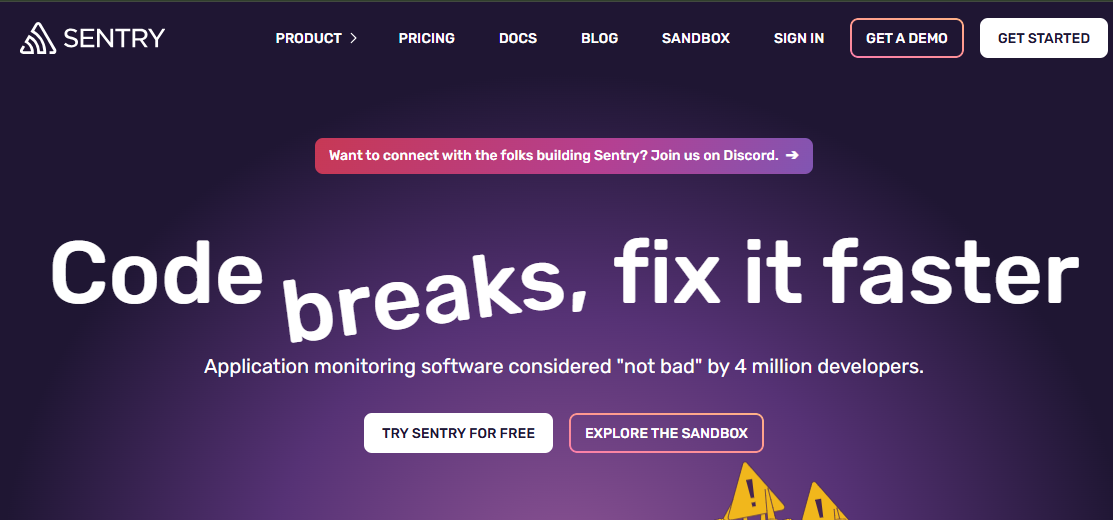
Known for:
Sentry is best known for real-time error tracking and performance monitoring designed specifically for developers. It focuses on frontend and backend application health, with deep integrations into code repositories, enabling rapid triaging and debugging.
Standout Features
- Code-Level Error Tracing: Links stack traces to source code, enabling developers to pinpoint bugs down to the commit and file.
- Performance Monitoring for Frontend/Backend: Offers spans, transaction tracing, and latency insights—optimized for app teams rather than infrastructure.
- GitHub/GitLab Integration: Connects releases, issues, and performance changes directly to code changes.
Key Features
1. Real-Time Application Monitoring
Captures runtime exceptions, API errors, and performance slowdowns across client and server apps with minimal instrumentation.
2. Session & Release Tracking
Monitors release impact, adoption, and error trends across application versions—great for product teams shipping fast.
3. Frontend + Backend Trace Views
Supports distributed tracing between frontend events and backend API calls with contextual performance insights.
4. Source Code Context
Stack traces show code snippets and owners via GitHub/GitLab integration, helping teams resolve issues faster.
5. Alerting and Issue Grouping
Sentry groups similar errors and lets teams set rules, alerts, and issue ownership based on path or tag.
Pros
- Excellent for developers needing fast debugging and visibility into app crashes
- Native code integration and version awareness
- Easy to set up and scale for frontend/backend teams
- Self-hosted version available for privacy-conscious orgs
- Lightweight alternative to full-stack APMs
Cons
- Limited infrastructure, metrics, and log observability
- No native support for OpenTelemetry or Prometheus
- Lacks deep APM features like anomaly detection or service maps
- Not built for full MELT observability—best used as a complementary tool
Best For
Developer-focused teams looking for error tracking, frontend performance monitoring, and release health insights—without needing full-stack observability.
Pricing & Customer Reviews
- Pricing: Free for 5K events; Paid three tier plans for team( $26/month), business($80/month), enterprise(custom)
- G2 Rating: 4.5/5
- Praised for: intuitive UI, debugging workflow, Git integration
- Criticized for: lack of infra observability and MELT coverage
Sentry vs Grafana
While Grafana targets infrastructure visibility and time-series dashboards, Sentry focuses entirely on application-level debugging. It lacks logs, metrics, or customizable dashboards but excels in developer productivity and frontend performance tracking. For app teams, Sentry complements Grafana—but doesn’t replace it for full observability.
Conclusion: Choosing the Right Grafana Alternative
While Grafana excels at dashboarding, it often falls short in delivering unified observability, automation, and cost predictability, especially at scale. As engineering teams look for tools that combine full MELT coverage, OpenTelemetry support, and compliance-ready deployments, alternatives like CubeAPM, Datadog, Dynatrace, and Coralogix are gaining traction.
Among these, CubeAPM stands out with its smart sampling engine, flat pricing, and OpenTelemetry-native architecture, delivering full-stack observability without the complexity or surprise costs of traditional APM platforms.
If you’re looking to go beyond visualizations and adopt a platform built for modern, scalable observability, CubeAPM is the best Grafana alternative to consider in 2025.


